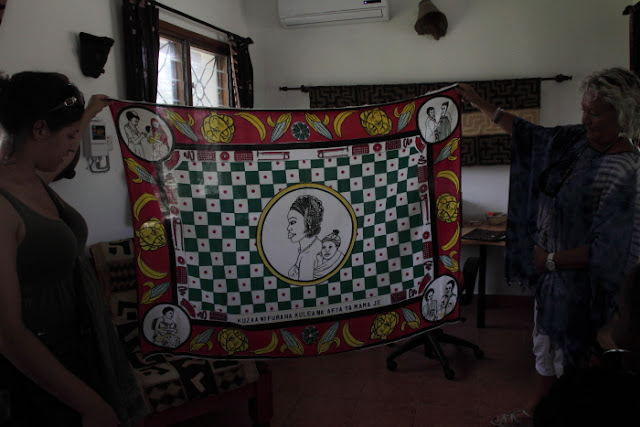Sometimes when the Norwegian students here go to town at night they hire a minibus - dala dala - to take them. The dala dala plays loud music all the way to town. I came along for the first time last week and it was an experience which put me in deep thoughts about the contrasts I'm experiencing here.
Driving through the poor villages playing loud music felt very wrong to me. It felt like we were shouting "everybody look at us, we're the rich white girls!" The people in the village were out with their goats and cows, or sitting outside their clay huts making food on an open fire, and we were going "out" to eat in a fancy pizza restaurant in town - where obviously only white European tourists went.
 |
| I prefer "eating out" with the Maasais |
 |
| Out taking pictures of the sunset |
I felt ashamed. Our fancy lifestyle could easily have paid for these children's education, medical treatments, food etc. It is already so obvious. Everybody knows that we are very rich and privileged compared to them, so it just rubs it in to show off our wealth like that. There are obviously a lot worse things we could've done, but this felt pretty bad to me still. Especially since we were doing it to the very people we will meet in the social projects. What will they think of us?
 |
| Clay huts in a village |
 |
| documenting with my fancy camera |
I see a lot of children and youth walking around with shirts from famous European football clubs. It's quite absurd to me that the poor people here care about European football and look up to the superstar professional football players with their insanely high wages and overextravagant lifestyles. The kids here can't even afford to buy a football, but they still admire people who are the pride examples of the unfair wealth distribution which causes their misery. I don't know if it is an escape from reality which can work as a survival strategy, or if it just gives them unrealistic dreams.
 |
| Home made football from the village |
 |
| Kids who just got a new football |
It's a bit like what we found during the health checks. The kids seem to be coping well with being hit, abused and neglected because they think it's normal. Would it be wrong of us to tell them that this treatment is wrong, that they deserve better? If we can't offer any improvement, wouldn't we just be taking away their ability to cope with their miserable conditions? It's something we would never have to consider in Norway. On the one hand, I strongly believe that information and enlightenment always is good and right. People should know about the unfair distribution of wealth in the world and that private and governmental corruption in addition is ruining this country and causing poverty and misery. It is wrong that people live in such extreme poverty when other people live with extreme unnecessary overspending. I do believe that if everybody truly knew about the unfairness of this situation, people would want to do something about it. On the other hand, I've started thinking about the way people adapt to their situation to at least secure their mental health. Yes, their situation is extremely unfair, but is it also unfair to take away their coping strategy with of our desire to enlighten them? Will it hurt more than it helps?
 |
| Reading a poster about AIDS at the youth centre |
It seems to be two potentially conflicting ways of looking at it. One way is looking at individual people's life and how to secure their short term happiness, and another is looking at the bigger picture and starting a process to get lasting long term improvements for larger number of people. The difficult task is to work with both perspectives in mind simultaneously cause they seem to be conflicting. It seems that a revolution-like process is needed to get the drastic improvements that would really make a difference to people's lives here, but it would take a long time and potentially make conditions worse for a while before (if) they eventually got better. When conditions are as bad as they are, it seems like the big improvements that are needed are so out of reach, that maybe it's not even worth trying. Maybe it's only possible to focus on individuals and slow symptom relief instead of attacking the whole unfair system which causes the problems. And maybe it's possible to get lasting improvements by fixing one little problem at the time. It is quite overwhelming to experience how unfair the world is and to feel like I'm a part of what makes it unfair. If I think of a good way of fixing it I will let you know!
I will end with a quote I read today: "There are two primary choices in life: to accept conditions as they exist, or to accept the responsibility for changing them.
-Denis Waitley



















